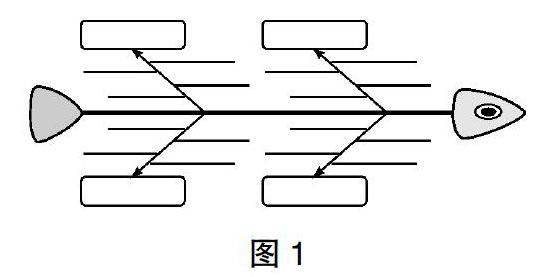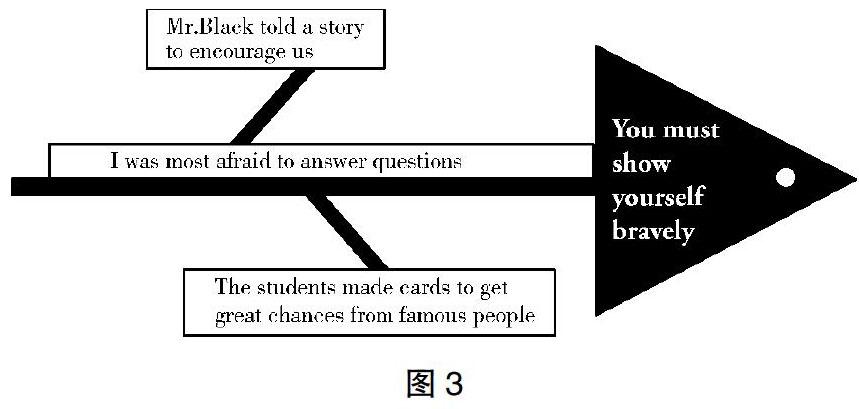鱼骨图在初中英语阅读主旨大意题中的应用探析
2020-08-31吴松林



【摘 要】鱼骨图是一种使复杂文章简单化、抽象问题具体化的解决文章主旨大意题的分析手段。在教学时,教师可以运用鱼骨图呈现初中阅读文章的结构——“总—分”“分—总”“总—分—总”“并—列”,提炼出更加具体和高效的理解文章的方法,教会学生定位文章主题句的位置,或者找出紧密联系的关键词,从而更准确地概括文章的主旨。鱼骨图的应用,可以激活学生的阅读思维,充分发挥学生的主动性,提高理解文章的动力。
【关键词】初中阅读;主旨大意题;鱼骨图
【作者简介】吴松林,二级教师。
【基金项目】广西基础教育教学改革质量提升项目“基于核心素养的初中‘普职融通课程模块化实施的探索与实践”
阅读理解题已成为中考英语的重要组成部分。在英语阅读理解中,主旨大意题主要考查学生对文章主题和中心思想的提炼与概括,是整体把握文章写作思路、分析文章逻辑和定位文章细节的基础。因此,主旨大意题对阅读理解所有题型的解题具有举足轻重的作用。鱼骨图是一种能够将抽象、复杂的问题用具体、形象的方式表现出来的图形。借助鱼骨图,我们可以将文章结构以直观、简洁的形式呈现出来,为学生提供高效的解题思路,提高他们对主旨大意题的解题能力。
一、魚骨图来源及分类
鱼骨图由日本管理大师石川馨先生发明,是一种发现问题“根本原因”的方法,又名“因果图”。它看上去有些像鱼骨,问题或结果通常标在鱼头处;鱼骨上长出鱼刺,按出现机会多寡列出产生问题的可能原因,有助于说明各个原因是如何影响后果的(如图1)。
鱼骨图一般分为三类,即整理问题型、原因型和对策型。整理问题型鱼骨图常用于各要素与特性值之间不存在因果关系而是结构构成关系的情况;原因型鱼骨图是鱼头在右,呈现由因至果的逻辑关系;对策型鱼骨图是鱼头在左,凸显由疑问到解题思维的形成过程。问题的特性总是受到一些因素的影响,画鱼骨图时要找出这些因素,整理成层次分明、条理清楚的结构,能够透过现象看本质[1]。
二、鱼骨图在初中英语四类文章阅读主旨大意题中的具体应用
初中英语阅读理解题的文章类型主要分为“总—分”“分—总”“总—分—总”“并列”四种结构。“总—分”结构是先对文章观点进行整体概括,然后分层叙述、说明或举例阐述。“分—总”结构则正好与前者相反。“总—分—总”结构是先有一个总述点明主题,然后分层叙述,最后再整体进行总结和升华。“并列”结构是各部分之间没有主次之分,每部分都有表达的重点和围绕同一主题开展的叙述。结构是文章部分与部分、部分与整体间的内在联系和外部形式的统一,是文章的“骨架”,集中反映了作者是如何进行谋篇布局的。鱼骨图可以更好展现以上四种文章类型的“骨架”,从而能够帮助学生更好地完成主旨大意题。
在初中英语阅读中,主旨大意题的设问方式主要有三种类型。
(1)概括文章主旨类:What is the passage mainly about?
(2)选择文章标题类:What is the best title of the passage?
(3)询问作者的写作态度和写作意图类:What is the writer's purpose in writing this passage?
1.鱼骨图在“总—分”结构文章中的应用
在英语阅读中,勾画鱼骨图是对文章信息重新整合、加工的过程。“总—分”结构在文章开头直接切入主题,或者在文章开头对背景进行阐述后,通过一个转折词提出作者的中心观点。鱼骨图能够将这类型的文章脉络(由主到次、由总到分)形象抽出,使学生清晰明了,快速定位并概括出主题。
【2018年广西贺州市英语中考题】
Sometimes you get so angry that you feel like you are going to burst!It may seem like your anger will be the boss of you.What can you do to control your anger and how to keep yourself and others healthier and safer?Here are some ideas to help you.
Take a deep breath before your heart slows down again.
Count from 1 to 10 slowly in your mind before you open your mouth.Then count another 10.Think about what to do or say before making a choice.
Walk away from the place that makes you angry.Go somewhere else until you've thought about what you can do.
Use your words to tell your feelings.Don't hurt anyone with your hands or feet.
Say what you feel in a low voice,not in a loud voice.
Sometimes you need to do something to let those angry feelings out.For example,doing a chore that you hate is a very good idea.It can get rid of your anger and you can feel better when that chore has been done.In this way,you will make anger become something useful.
Q:What's the best title of this passage?
在第一段末尾,作者开门见山地点明文章所要探索的问题并明确告诉读者,接下来将列举一些关于控制愤怒的建议。这是一篇典型的“总—分”结构的文章。在此,我们可以从问题出发寻找策略,绘制出对策型鱼骨图。鱼头在左,写出本篇文章的问题“What can you do to control your anger”,再结合每一根鱼脊上的骨头,根据接下来每一段的首句,分别在鱼骨上列举出作者提出的控制愤怒的技巧(如图2)。根据图形,学生可以很清晰地看出文章的核心信息,快速分析出这篇文章的结构,进而在教师的引导下于文章开头部分快速定位出主题句,得到正确答案,同时,还可以根据鱼脊上列举的细节信息,更加准确、快速地排除错误选项。
对策型鱼骨图可以帮助学生更高效地架构篇章、厘清文章脉络,快速定位主题句以概括文章大意。同时,学生也明白了要准确把握“总—分”结构文章的主题,就要定位到开头(一般是首段或者第二段),寻找能够概括文章的主题句。
2.鱼骨图在“分—总”结构文章中的应用
“分—总”结构遵循了“先提出背景再分论点来阐述和支撑主要論点,最后总结出主要论点”这样一条脉络来构建文章,由浅入深,层层叙述,以揭示文章的主旨。我们可以将这类文章结构绘制成原因型鱼骨图,即鱼头在右边,让学生明晰文章的发展顺序。
【2014年广西南宁市英语中考题】
As a student,I was most afraid to answer questions in class,and I found that the students around were just like me.At the beginning of each class,when the teacher asked a question,I always lowered my head because I was afraid that the teacher saw me.
One day,in a foreign language class,Mr.Black gave us a lesson.He wanted us to be active in class,so he asked us some questions,but no one answered.“Let me tell you a story first,”he said.
“When I came to the United States to study,the university often invited famous people to make speeches.Before the beginning of every speech,I found an interesting thing.The students around me always took a cardboard folded in half,wrote their names in bold with the most eye-catching color,and then placed the cardboard on the seat.So when the speaker needed the answers from the students,he could see and call a listener's name directly.”
“I couldn't understand that.My classmate told me the speakers were all top people,who meant chances.When your answer was to his surprise,it meant he might give you more chances.In fact.I really saw a few students got great chances because of that.”
After listening to the story,I understood that the chance will not find you itself.You must show yourself all the time so that you can find a chance on the card.
Q:What does the writer mainly tell us?
文章描述了“我”和同学们在课堂上都害怕回答问题,为了鼓励我们,布莱克先生给我们讲了一个他在大学里的故事,最终我们在故事中得到了启发,即你要时刻展现自己,这样才能获得好机会。这是一篇比较典型的“分—总”结构的文章。在此,我们可以由原因导向出发,寻找解决策略,总结结果。首先,在鱼脊上写出故事展开的原因,指出存在的问题“是什么”;接着,旁侧展开两根鱼骨,描述布莱克先生“如何做”,以及他所见到的学生“如何做”;最后,揭示出一个要勇于展现自己的道理,这个道理就放在最后的鱼头上(如图3)。根据图形,学生可以很清晰地看到文章层层递进的结构,由现象深入事情的本质,在末尾部分升华文章的主题。学生也可以很直观看出这篇文章的结构,从而在文章末尾部分快速定位主题句,揭示出文章的中心思想。
成因型鱼骨图可以帮助学生厘清文章和事情的发展线索,明白如何把握“分—总”结构的主旨大意:定位文章末尾(一般是最后一段),寻找能够归纳文章大意的主题句。
3.鱼骨图在“总—分—总”结构文章中的应用
在“总—分—总”结构的文章中,作者一般会在文章开头直接开宗明义指出主题,再经过具体的阐述和列举,在文末再一次点明主题。我们可以将这类文章结构绘制成鱼骨图。
【2017年廣西北部湾英语中考题】
Why are dogs our best friends?Maybe because they can understand our words much better than we thought,according to a study in Hungary.It found that dogs understand not only what we say,but also how we say it.
“The results were very exciting and very surprising.”said researcher Attila Andics,from Eotvos Lorand University in Budapest.
For the study,the researchers first trained 13 dogs for months.The dogs had to sit quietly inside machines,so that the researchers could check their brain activity.
Then the researchers put headphones on dogs and played people's voices to them.There were four different voices.Some were positive words,such as “well done”,or neutral words like “however”.The words were also in different tones.Some were positive and some were neutral.
Brain scans showed that the dogs could recognize words,as well as the tone of words,much like people do.The positive words with a positive tone brought the stronger activity in their brain's reward centers.
“It shows that for dogs,a nice phrase can work very well as a prize,but it works best if both words and tones match.”said Andics.
They also found that dogs deal with meaningful words with the left side of the brain and tones with the right.Human brains work in the same way.
It gave us a new understanding of language,said Andics.That is,not only humans understand the meaning in words,other species do too.
Q:What is the main idea of the passage?
文章首段就点明了主题,根据一项研究发现,狗不仅能听懂我们说的话,还能听懂我们说话的方式。因此,我们可以明确地将这个研究主题描绘在鱼头部分(如图4)。文章中间部分是对这项研究的具体阐述,可以用四根分支的鱼骨描绘具体细节和四个结果。这四个研究结果是狗可以识别词意、狗能识别词的语气、狗能用左脑处理有意义的词语和狗能用右脑处理音调。文章从多角度、多层次来说明狗可以对人类的语言做出相应的反应。文章末尾形成的结论是作者对主题的进一步总结和深化,可以绘制成鱼尾。根据图形,学生可以清楚地看到文章是“总—分—总”结构,也可以明白文章是如何从多方面论证和支撑开头提出的主题的,并在末尾再一次深化主旨大意。
鱼骨图可以让学生理解“总—分—总”结构的发展过程,明白在做题时既要定位文章的开头又要定位文章的末尾,且这两个主题句之间具有前后呼应的特点。
4.鱼骨图在“并列”结构文章中的应用
在“并列”结构的文章中,不会出现明显的主题句,这就非常考验学生由表及里地对文章情节进行分析。这类文章通常会反复出现一些联系紧密的关键词,我们可以把其绘制成整理问题型鱼骨图,使各要素之间既独立存在,又紧密相连,让学生能够根据图示对关键词进行高度概括和进一步加工理解,从而概括出文章的主旨大意。
【2018年广西北部湾英语中考题】
Once there was a famine.A rich cook sent for twenty of the poorest children in the town and said to them,“In this basket there is a piece of bread for each of you.Take it and come back to me every day at this hour for more.”
In a hurry the hungry children got together around the basket,and fought over the bread because each wanted the largest piece.At last they went away without even thanking the good cook.Mary,a poorly-dressed girl,did not fight with the other children,but stood quietly in distance.When the badly-behaved children had left,Mary took the smallest piece,which was all left in the basket.She kissed the cook's hand and went home.
The next day the children were as badly-behaved as before.Mary got a piece of bread almost half the size of the one she got the first day.When she came home,her mother cut the bread open.Many new,shining pieces of silver fell out of it.
Her mother was very worried,and said,“Take the money back to the cook at once.The silver must have fallen into the dough by accident.Hurry up,Mary.”
When the little girl gave the rich man her mother's message,he said,“It was no mistake.I had the silver pieces put into the smallest bread for you as a prize.Always be as satisfied,peaceable and thankful as you now are.Go home now,and tell your mother that the money is yours.”
Q:What is the passage mainly about?
这篇文章并没有明确的主题句,但是我们可以留意到一些反复出现或者可以集中概括出主题的关键词,从而整理出一条故事线。鱼骨的分支就是每一段的关键词。这些关键词都突出一个叫Mary的女孩有着美好的品质,故我们可以罗列出几个形容词概括出Mary的优点(见图5)。根据图形,学生既可以清楚地看到文章是“并列”结构,也可以看清故事发展的脉络,能更高效地把分散在各段的关键词集合起来,发现其内在联系,从而归纳出主题,得到正确答案。
整理问题型鱼骨图可以让本来形似分散的文章显然更加有条理,让学生更加清晰地看到文章反复提及的、可以集中概括文章主题的关键词,让学生深刻理解“并列”结构各段间的深层联系。
三、总结
鱼骨图是以鱼头、鱼骨、鱼尾组成的图形,以用鱼头或鱼尾表示文章的主题句,以文章发展的线索或紧密相关的关键词为支线,形象地支撑起文章结构。思维可视化能够优化知识的呈现方式[2],是最直观的一种分析文章的方式,使文章脉络更清晰、更具体,可以使学生在记忆各类文章结构时更加容易、更加深刻。相比于文字,图形更能够激起学生对主旨大意题的阅读兴趣,提高阅读效率。主旨大意题是初中生感到困惑和害怕的一种题型,因为初中生对语言的掌握尚处于积累阶段,而主旨大意题对学生的綜合分析能力、对文章整体的理解和加工能力、概括能力要求较高。鱼骨图作为载体,能让学生在学习时更有耐心,从而充分调动起内在的学习动力。
参考文献:
[1]彭玉华.利用“鱼骨图”提高学生分析能力[J].教学月刊·中学版(语文教学),2019(12):28-31.
[2]颜敏.思维可视化初中英语阅读教学的应然之路[J].中学信息技术教育,2019(11):44-46.
(责任编辑:周彩珍)
